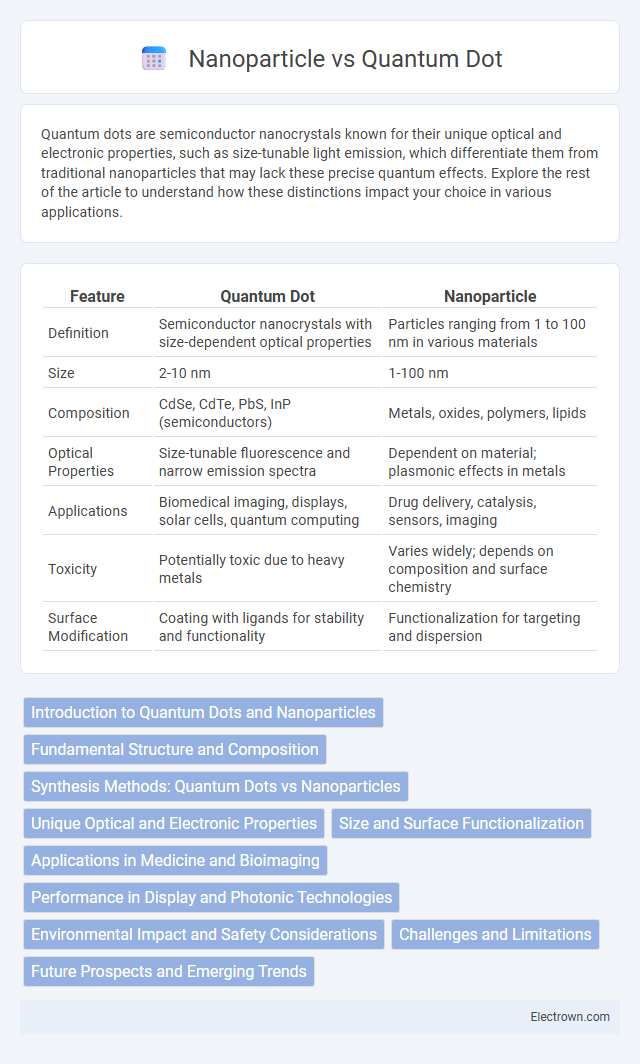Quantum dots are semiconductor nanocrystals known for their unique optical and electronic properties, such as size-tunable light emission, which differentiate them from traditional nanoparticles that may lack these precise quantum effects. Explore the rest of the article to understand how these distinctions impact your choice in various applications.
Table of Comparison
| Feature | Quantum Dot | Nanoparticle |
|---|---|---|
| Definition | Semiconductor nanocrystals with size-dependent optical properties | Particles ranging from 1 to 100 nm in various materials |
| Size | 2-10 nm | 1-100 nm |
| Composition | CdSe, CdTe, PbS, InP (semiconductors) | Metals, oxides, polymers, lipids |
| Optical Properties | Size-tunable fluorescence and narrow emission spectra | Dependent on material; plasmonic effects in metals |
| Applications | Biomedical imaging, displays, solar cells, quantum computing | Drug delivery, catalysis, sensors, imaging |
| Toxicity | Potentially toxic due to heavy metals | Varies widely; depends on composition and surface chemistry |
| Surface Modification | Coating with ligands for stability and functionality | Functionalization for targeting and dispersion |
Introduction to Quantum Dots and Nanoparticles
Quantum dots are semiconductor nanocrystals measuring 2 to 10 nanometers in diameter, renowned for their size-tunable optical and electronic properties. Nanoparticles encompass a broader category of particles between 1 to 100 nanometers, including metals, metal oxides, and polymers, with diverse applications across medicine, electronics, and materials science. Both quantum dots and nanoparticles exhibit unique quantum mechanical behaviors due to their nanoscale dimensions, influencing their absorption, emission, and surface reactivity characteristics.
Fundamental Structure and Composition
Quantum dots are semiconductor nanocrystals typically composed of groups II-VI or III-V elements, possessing a precise crystalline lattice structure that enables size-dependent quantum confinement effects. Nanoparticles encompass a broader category of particles ranging from metals like gold and silver to metal oxides and polymers, with diverse morphologies and compositions affecting their physical and chemical properties. Your understanding of fundamental structure hinges on recognizing that quantum dots have a rigid atomic lattice promoting discrete energy levels, whereas nanoparticles may have amorphous or less-defined structures leading to varying behavior.
Synthesis Methods: Quantum Dots vs Nanoparticles
Quantum dots are typically synthesized using techniques such as colloidal synthesis, molecular beam epitaxy, or chemical vapor deposition, which allow precise control over size and shape to tune their optical properties. Nanoparticles, on the other hand, are produced via a broader range of methods including sol-gel processing, hydrothermal synthesis, and green synthesis, offering versatility in composition and morphology. Your choice between the two depends on the required uniformity, scalability, and application-specific functionality critical for quantum dot or nanoparticle integration.
Unique Optical and Electronic Properties
Quantum dots exhibit size-dependent optical and electronic properties due to quantum confinement effects, resulting in tunable emission wavelengths and high photostability ideal for precise applications. Nanoparticles, while also offering unique optical traits such as surface plasmon resonance, generally lack the discrete energy levels seen in quantum dots, impacting their spectral sharpness. Your choice between quantum dots and nanoparticles will hinge on the need for specific emission control and electronic behavior tailored to advanced imaging or sensing technologies.
Size and Surface Functionalization
Quantum dots typically measure 2 to 10 nanometers in diameter, exhibiting size-dependent optical and electronic properties due to quantum confinement effects. Nanoparticles vary widely in size, generally ranging from 1 to 100 nanometers, and their surface functionalization involves attaching specific ligands or polymers to tailor stability, biocompatibility, and targeting capabilities. Quantum dot surface functionalization often includes thiol, amine, or carboxyl groups to enhance solubility and facilitate bioconjugation, crucial for applications in bioimaging and sensing.
Applications in Medicine and Bioimaging
Quantum dots offer superior fluorescence stability and tunable emission wavelengths, making them highly effective for bioimaging applications such as targeted cell labeling and in vivo imaging. Nanoparticles, including gold and silica variants, provide versatile platforms for drug delivery, photothermal therapy, and contrast enhancement in medical diagnostics. Both quantum dots and nanoparticles enable precise molecular targeting and real-time monitoring, advancing personalized medicine and early disease detection.
Performance in Display and Photonic Technologies
Quantum dots exhibit superior color purity and brightness in display technologies compared to conventional nanoparticles due to their size-tunable emission wavelengths and narrow spectral linewidths. Their high quantum yield and stability enable enhanced performance in photonic devices such as LEDs and lasers, delivering more efficient light emission and improved energy conversion. Nanoparticles, while useful in various applications, generally lack the precise emission control and spectral sharpness critical for advanced display and photonic technologies.
Environmental Impact and Safety Considerations
Quantum dots exhibit unique optical properties but often contain heavy metals like cadmium, raising significant environmental and toxicity concerns during disposal and manufacturing. Nanoparticles vary widely in composition, with some biodegradable options reducing ecological risks, yet their small size can still pose unknown health hazards through bioaccumulation or respiratory exposure. Comprehensive life-cycle assessments and strict regulatory frameworks are essential to mitigate environmental damage and ensure safe handling of both quantum dots and nanoparticles in industrial applications.
Challenges and Limitations
Quantum dots face challenges including toxicity due to heavy metal content, limited stability under prolonged illumination, and complex, costly synthesis methods. Nanoparticles encounter limitations such as broad size distribution affecting consistency, potential aggregation in biological systems, and difficulties in precise functionalization for targeted applications. Both quantum dots and nanoparticles require advancements in surface modification and biocompatibility to overcome these hurdles for widespread use in biomedical and electronic fields.
Future Prospects and Emerging Trends
Quantum dots exhibit superior optical properties and tunable emission spectra compared to conventional nanoparticles, positioning them as key materials in the future of display technologies and biomedical imaging. Emerging trends highlight the integration of quantum dots in flexible electronics and quantum computing, driven by advancements in synthesis techniques that enhance their stability and biocompatibility. Your investment in understanding these materials can unlock groundbreaking innovations in photonics and nanomedicine.
Quantum dot vs Nanoparticle Infographic

 electrown.com
electrown.com